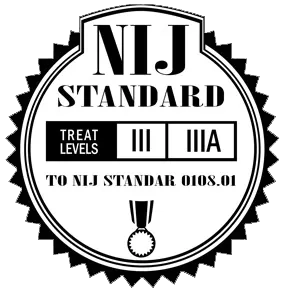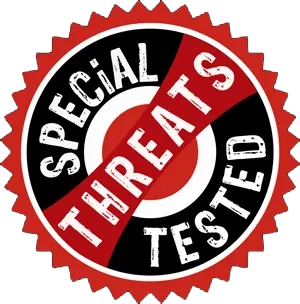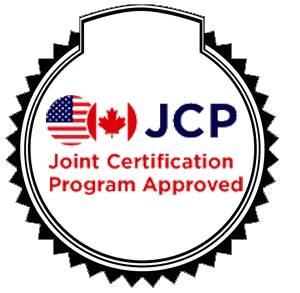2024 NIJ Standard 0123.00 Ballistic Shield Specifications
The 2024 NIJ Standard 0123.00 provides detailed specifications for ballistic shields and their protection levels, including NIJ HG1, NIJ HG2, NIJ RF1, NIJ RF2, and NIJ RF3. Below is an overview of the specifications for each of these protection levels, including the type of threats they are designed to stop, the reference velocities, and other key parameters.
NIJ HG1 (Handgun Protection - Low Velocity)
| Specification | Details |
|---|
| Protection Level | HG1 |
| Tested Threats | Low-velocity handgun rounds |
| Example Ammunition | 9mm FMJ (115gr), .38 Special |
| Reference Velocity | ~1,200–1,300 ft/s |
| Minimum Coverage Area | 100% of the shield area must protect against the threat. |
| Backface Deformation | Maximum allowed deformation: 44 mm (1.75 inches) |
| Test Type | Single shot testing at designated impact points on shield |
| Use Case | Personal defense, standard law enforcement use, and general civilian protection. Designed for environments with low-risk handgun threats. |
NIJ HG2 (Enhanced Handgun Protection - Higher Velocity)
| Specification | Details |
|---|
| Protection Level | HG2 |
| Tested Threats | High-velocity handgun rounds |
| Example Ammunition | 9mm +P (124gr), .40 S&W (180gr) |
| Reference Velocity | ~1,200–1,400 ft/s |
| Minimum Coverage Area | 100% of the shield area must protect against the threat. |
| Backface Deformation | Maximum allowed deformation: 44 mm (1.75 inches) |
| Test Type | Single shot testing at designated impact points on shield |
| Use Case | Tactical law enforcement, enhanced personal protection, and environments with higher velocity handgun threats. Ideal for use where more powerful handguns (like .40 S&W and 9mm +P) may be present. |
NIJ RF1 (Rifle Protection - Intermediate Velocity)
| Specification | Details |
|---|
| Protection Level | RF1 |
| Tested Threats | Intermediate rifle rounds |
| Example Ammunition | 7.62mm NATO (147gr), 5.56mm NATO (55gr) |
| Reference Velocity | ~2,700–2,900 ft/s |
| Minimum Coverage Area | 100% of the shield area must protect against the threat. |
| Backface Deformation | Maximum allowed deformation: 44 mm (1.75 inches) |
| Test Type | Single shot testing at designated impact points on shield |
| Use Case | Protection against military or tactical rifles in law enforcement and military operations. Effective against intermediate rifle threats. |
NIJ RF2 (Rifle Protection - Armor-Piercing)
| Specification | Details |
|---|
| Protection Level | RF2 |
| Tested Threats | Armor-piercing rifle rounds |
| Example Ammunition | .30-06 AP (166gr), 7.62mm NATO API |
| Reference Velocity | ~2,800–3,000 ft/s |
| Minimum Coverage Area | 100% of the shield area must protect against the threat. |
| Backface Deformation | Maximum allowed deformation: 44 mm (1.75 inches) |
| Test Type | Single shot testing at designated impact points on shield |
| Use Case | Designed for environments with armor-piercing rifle threats, used in military operations or high-risk tactical operations. |
NIJ RF3 (High-Level Rifle Protection - Military)
| Specification | Details |
|---|
| Protection Level | RF3 |
| Tested Threats | High-velocity, armor-piercing military rounds |
| Example Ammunition | 7.62mm NATO API, .50 BMG |
| Reference Velocity | ~3,000–3,200 ft/s |
| Minimum Coverage Area | 100% of the shield area must protect against the threat. |
| Backface Deformation | Maximum allowed deformation: 44 mm (1.75 inches) |
| Test Type | Single shot testing at designated impact points on shield |
| Use Case | Extreme protection for military combat or high-risk tactical operations where .50 BMG or similar threats are present. |
Summary of Protection Levels
| Protection Level |
Description |
Tested Threats |
Example Ammunition |
Velocity Range |
| NIJ HG1 |
Low-velocity handgun protection |
Standard handgun rounds like 9mm FMJ, .38 Special |
9mm FMJ (115gr), .38 Special |
~1,200–1,300 ft/s |
| NIJ HG2 |
Enhanced handgun protection |
Higher-velocity handgun rounds such as 9mm +P, .40 S&W |
9mm +P (124gr), .40 S&W (180gr) |
~1,200–1,400 ft/s |
| NIJ RF1 |
Intermediate rifle protection |
Intermediate rifle rounds like 5.56mm NATO, 7.62mm NATO |
5.56mm NATO (55gr), 7.62mm NATO (147gr) |
~2,700–2,900 ft/s |
| NIJ RF2 |
Armor-piercing rifle protection |
Armor-piercing rifle rounds like 7.62mm NATO API, .30-06 AP |
7.62mm NATO API, .30-06 AP |
~2,800–3,000 ft/s |
| NIJ RF3 |
High-level rifle protection (military) |
High-velocity armor-piercing rounds like .50 BMG |
.50 BMG, 7.62mm NATO API |
~3,000–3,200 ft/s |
Key Takeaways
- HG1 and HG2 provide protection for handgun threats, with HG2 offering protection against higher-velocity handgun rounds.
- RF1 offers protection for intermediate rifle rounds such as 5.56mm NATO and 7.62mm NATO.
- RF2 and RF3 are designed to stop armor-piercing rifle rounds, with RF3 offering the highest protection, including defense against .50 BMG and other extreme military-grade ammunition.
These updated specifications provide a clear understanding of the protection offered by each level and ensure that ballistic shields are tested rigorously to meet the evolving threats faced by law enforcement, military, and security personnel.








